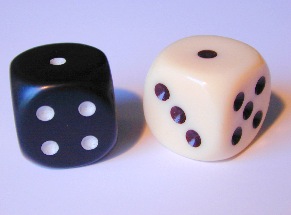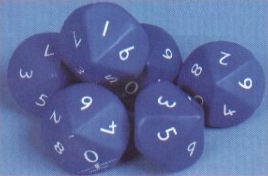Copyright © University of Cambridge. All rights reserved.
'A Bit of a Dicey Problem' printed from https://nrich.maths.org/
Show menu
Why do this problem?
This problem gives plenty of chance for practising addition in a meaningful context whilst avoiding the monotony of doing a set of written calculations. As the context is an investigative one, the teacher will have plenty of opportunity to observe the children at work and assess their skills, with addition in the
first instance. However, subtraction and multiplication may also be possible if you change the operation in the question. The game is also an opportunity to model working systematically.
Possible approach
This is a low threshold high ceiling activity that would be suitable for a range of pupils and enable them all to be working on the same activity but using different skills to reach their conclusions.
Introduce the task by getting the children to throw two dice in pairs with one throwing the dice and one recording the results. If each pair in the class records their results for 5 throws then collectively they can make a conjecture about what the outcomes may be.
After a number of trials they may be willing to make a hypothesis about the most likely result. It is important to press them to offer a rationale for their choice at this stage. They may be willing to justify their choice on the basis of an argument that doesn't involve collecting lots of examples or they may only be prepared to use the evidence that they have gathered.
They could record their arguments and justifications by using a video camera, or on paper and then share them with the rest of the class at intervals during the lesson.
Introduce the task by getting the children to throw two dice in pairs with one throwing the dice and one recording the results. If each pair in the class records their results for 5 throws then collectively they can make a conjecture about what the outcomes may be.
After a number of trials they may be willing to make a hypothesis about the most likely result. It is important to press them to offer a rationale for their choice at this stage. They may be willing to justify their choice on the basis of an argument that doesn't involve collecting lots of examples or they may only be prepared to use the evidence that they have gathered.
They could record their arguments and justifications by using a video camera, or on paper and then share them with the rest of the class at intervals during the lesson.
Key questions
What results can you make?
How can you be sure you have considered all the possibilities?
Are you getting one result more often than the others?
What do you notice about the number of 1s, 2s, 3s,... that you have?
How can you be sure you have considered all the possibilities?
Are you getting one result more often than the others?
What do you notice about the number of 1s, 2s, 3s,... that you have?
Possible extension
Consider other operations such as the difference between the numbers or the total on the white die subtract the total on the black die. What possible results would these give? Why? Which would be the most likely now?
Consider other polyhedra dice or a mix of different dice.
What about dice that have different sets of numbers on them, such as a six sided dice having 2,4,6,8,10,12 on the faces?
Consider other polyhedra dice or a mix of different dice.
What about dice that have different sets of numbers on them, such as a six sided dice having 2,4,6,8,10,12 on the faces?
Possible support
Some children will need to spend longer convincing themselves about the possible answers to the addition sums and even to use apparatus to help them. Allow them the time to do so. If children work in pairs then this often helps them to articulate their thinking to one another, which will help them both. The child who has 'got it' will clarify their thinking as they explain. The one who
hasn't should be encouraged to ask questions until they do understand. It is the repsonsibility of them both to ensure that they are secure in their understanding of what they are doing.

